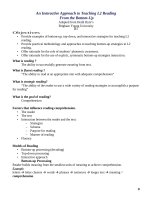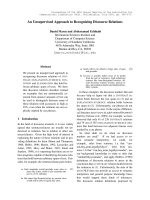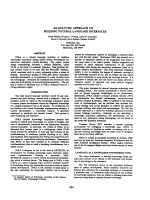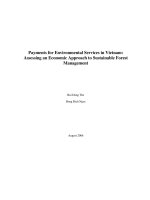An Interactive Approach to Teaching L2 Reading
Bạn đang xem bản rút gọn của tài liệu. Xem và tải ngay bản đầy đủ của tài liệu tại đây (121.5 KB, 3 trang )
An Interactive Approach to Teaching L2 Reading
From the Bottom-Up
Adapted from Heidi Hyte’s
Brigham Young University
Objectives
• Provide examples of bottom-up, top-down, and interactive strategies for teaching L2 reading.
• Provide practical methodology and approaches to teaching bottom-up strategies in L2 reading.
• Offer rationale for the role of students’ phonemic awareness.
• Offer rationale for the use of explicit, systematic bottom-up strategies instruction.
What is reading ?
The ability to successfully generate meaning from text.
What is fluent reading ?
“The ability to read at an appropriate rate with adequate comprehension”
What is strategic reading?
“The ability of the reader to use a wide variety of reading strategies to accomplish a purpose
for reading”
What is the goal of reading?
Comprehension
Factors that influence reading comprehension.
• The reader
• The text
• Interaction between the reader and the text:
– Strategies
– Schema
– Purpose for reading
– Manner of reading
• Fluency
Models of Reading
• Bottom-up processing (decoding)
• Top-down processing
• Interactive approach
Bottom-up Processing
Reader builds meaning from the smallest units of meaning to achieve comprehension.
Example
letters à letter clusters à words à phrases à sentences à longer text à meaning =
comprehension
Top-down Processing
8
Reader generates meaning by employing background knowledge, expectations, assumptions,
and questions, and reads to confirm these expectations.
Example
Pre-reading activities (i.e. activating schema, previewing, and predicting) + background knowledge
(cultural, linguistic, syntactic, and historical) = comprehension
Interactive Approach
Reader uses both bottom-up and top-down strategies simultaneously or alternately to comprehend the
text.
Example
Reader uses top-down strategies until he/she encounters an unfamiliar word, then employs decoding
skills to achieve comprehension.
Knowledge base + bottom-up strategies + top-down strategies = comprehension
Which model should be adopted?
The reader must be competent in both bottom-up and top-down processing.
Interaction (“balance”) of
bottom-up and top-down strategies:
Why bottom-up ?
“Despite the emergence of interactive models, I am concerned that much of the second
language reading literature continues to exhibit a strongly top-down bias… This research has resulted
in many useful insights, but the lack of attention to decoding problems has, I think, produced a
somewhat distorted picture of the true range of problems second language readers face”
“In practical terms, my concern is thus to keep the language in the teaching of second
language reading. That may not sound very controversial, but I think that in promoting higher-level
strategies--like predicting from context or the use of schemata and other kinds of background
knowledge--some researchers have been sending a message to teachers that the teaching of reading to
second language readers is mostly just a mater of providing them with the right background
knowledge for any texts they must read, and encouraging them to make full use of that knowledge in
decoding those texts. Though that is certainly important, it is also, I think, potentially misleading as
a total approach…We must not, I believe, lose sight of the fact that language is a major problem in
second language reading, and that even educated guessing at meaning is not a substitute for accurate
decoding” .
What’s your opinion?
“The introduction of top-down processing has had such a profound impact on second
language reading that there has been a tendency to view the introduction of a strong top-down
processing perspective as a substitute for the bottom-up, decoding view of reading, rather than its
complement” .
Self Reflection
8
Top-downBottom-up
Bottom-up Top-down
1) What strategies do YOU use to teach reading?
2) When you learned how to read, did you learn both bottom-up and top-down skills?
3) When you teach reading, do you rely more on teaching top-down strategies? If so, why?
4) Are you an interactive reading teacher ?
SOURCES
Aebersold, J. & Field, M. L., (1997). From reader to reading teacher: Issues and strategies
for second language classrooms. New York: Cambridge University Press.
Anderson, N. J. (2003). Exploring Skills: Reading. In D. Nunan (Ed.), Practical English
Language Teaching (pp. 67-86). New York: McGraw-Hill.
Birch, B. M, (2002). English L2 Reading: Getting to the Bottom. Mahwah, New Jersey:
Lawrence Erlbaum Associates.
Carrell, P. (1993). Introduction: Interactive approaches to second language reading. In P.
Carrell, J. Devine, & D. Eskey (Eds.), Interactive approaches to second language reading (pp. 1-7).
Cambridge, England: Cambridge University Press.
Eskey, D. (1993). Holding in the bottom: An interactive approach to the language problems
of second language readers. In P. Carrell, J. Devine, & D. Eskey (Eds.), Interactive approaches to
second language reading (pp. 93-100). Cambridge, England: Cambridge University Press.
Nunes, T. (1999). Learning to read: An integrated view from research and practice.
Dordrecht, The Netherlands: Kluwer.
8







